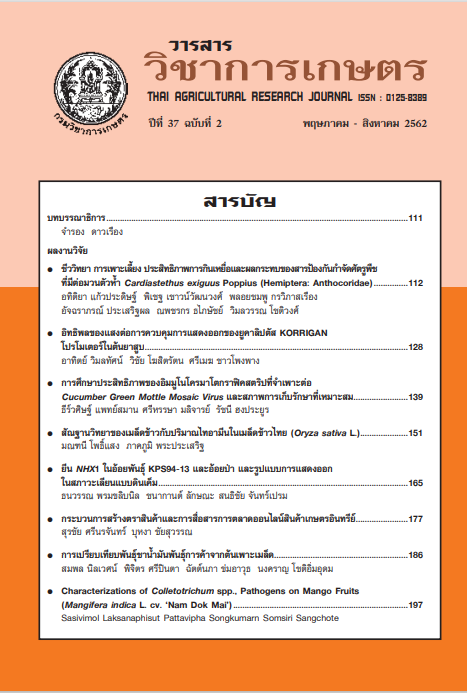การศึกษาประสิทธิภาพของอิมมูโนโครมาโตกราฟิคสตริปที่จำเพาะต่อ Cucumber Green Mottle Mosaic Virus และสภาพการเก็บรักษาที่เหมาะสม
DOI:
https://doi.org/10.14456/thaidoa-agres.2019.13คำสำคัญ:
พืชตระกูลแตง, การตรวจสอบ, การประเมินผล, การเก็บรักษา, ชุดตรวจสอบแบบรวดเร็วบทคัดย่อ
อิมมูโนโครมาโตกราฟิคสตริป (Immunochromatographic Strip; ICS) เป็นชุดตรวจสอบที่ใช้ง่าย สะดวก และรวดเร็ว มีประโยชน์มากในการตรวจสอบเชื้อไวรัสพืช ซึ่งการเก็บรักษาที่เหมาะสมจะช่วยรักษาประสิทธิภาพการใช้งานให้ยาวนานขึ้น งานวิจัยนี้ได้ผลิต ICS ที่มีความจำเพาะต่อเชื้อ Cucumber green mottle mosaic virus (CGMMV) ประเมินประสิทธิภาพการตรวจเชื้อไวรัสเป้าหมาย และศึกษาสภาพการเก็บรักษาที่เหมาะสมโดยเปรียบเทียบบรรจุภัณฑ์ สภาพแสง และอุณหภูมิ ได้แก่ หลอดทดสอบหรือถุงซิป สภาพแสงธรรมชาติหรือที่มืด และอุณหภูมิห้องหรือที่ 4°oซ. ตามลำดับ ผลการทดสอบพบว่า ICS ที่ผลิตได้มีคุณภาพดี มีความจำเพาะสูงกับเชื้อ CGMMV มีความไวในการตรวจไวรัสบริสุทธิ์ที่ระดับ 0.098 ไมโครกรัม/มล. หรือตรวจน้ำคั้นพืชเป็นโรคที่เจือจางได้ถึง 1:10,000 และสามารถตรวจเชื้อ CGMMV ในสารละลายดินได้ที่ระดับความเข้มข้น 0.024 ไมโครกรัม/มล. การอ่านผลใช้เวลาเพียง 5 นาที ผลการศึกษาสภาพที่เหมาะสมในการเก็บรักษา ICS พบว่า ควรเก็บ ICS โดยมีสารดูดความชื้นในหลอดทดสอบหรือถุงซิป ที่อุณหภูมิ 4°oซ. ในสภาพที่มืด ซึ่งช่วยรักษาประสิทธิภาพในการตรวจสอบได้เป็นระยะเวลาอย่างน้อย 12 เดือน
เอกสารอ้างอิง
2. รัชนี ฮงประยูร. 2558. เทคนิคทางซีรัมวิทยาในการวินิจฉัยโรคพืช. เพชรเกษมพริ้นติ้ง กรุ๊ป, นครปฐม. 87 หน้า.
3. สุพจน์ ภูมิสุข. 2551. การผลิตแอนติบอดีและการตรวจเชื้อ Cucumber green mottle mosaic virus ใน แตงกวา.วิทยานิพนธ์ปริญญาโทสาขาวิชาเทคโนโลยีชีวภาพเกษตร. มหาวิทยาลัยเกษตรศาสตร์, กรุงเทพฯ.
4. สำนักวิจัยพัฒนาการอารักขาพืช, กรมวิชาการเกษตร, กระทรวงเกษตรและสหกรณ์. 2550. การผลิตชุดตรวจสอบไวรัสเพื่อใช้เอง GLIFT kit. กรมวิชาการเกษตร,กรุงเทพฯ. 50 หน้า.
5. ยุทธ ทนโม๊ะ, เพชรรัตน์ ธรรมเบญจพลและพิศาลศิริธร. 2547. การอุบัติของเชื้อไวรัสที่มีความสัมพันธ์ทางเซรุ่มวิทยากับเชื้อ Cucumber green mottle mosaic virusในแหล่งผลิตเมล็ดพันธุ์แตงและวิธีการผลิตแอนติซีรั่มที่จําเพาะต่อเชื้อ,หน้า 227- 236.ใน การประชุมทางวิชาการประจําปี พ.ศ. 2547 ของสมาคมเทคโนโลยีชีวภาพแห่งประเทศไทยครั้งทที่ 16 “นวัตกรรม เทคโนโลยีชีวภาพ:หนึ่งทางเลือกเพื่อยกระดับสู่ครัวของโลก” วันที่ 12-15 ธันวาคม พ.ศ. 2547 ณ โรงแรมท็อปแลนด์, จังหวัดพิษณุโลก.
6. Ainsworth, G.C. 1935. Mosaic disease of the cucumber. Annals Appl. Biol. 22:55–67. Dombrovsky, A., L.T.T. Tran-Nguyen and R.A.C. Jones. 2017.Cucumber green mottle mosaic virus: Rapidly increasing global distribution, etiology, epidemiology, and management. Ann. Rev.Phytopathol. 55:231–256.
7. Fletcher, J.T. 1969. Cucumber green mottle mosaic virus, its effect on yieldand its control in the Lea Valley, England. Plant Pathol. 18:16–22.
8. Hollings, M., Y. Komuro and H. Tochihara. 1975. Cucumber green mottle mosaic virus.Available Source: https://www.dpvweb.net/showadpv.php?dpvno=154, April, 28, 2008.
9. Inoue, T., N. Inoue, M. Asatani and K. Mitsuhata. 1967. Studies on Cucumber green mottle mosaic virus in Japan (in Japanese). Nogaku Kenkyu 51: 175–186.
10. Komuro, Y., H. Tochihara, R. Fukutsu, Y. Nagai and S. Yoneyama. 1968. Cucumber green mottle mosaic virus on watermelon in Chiba and Ibaraki Prefectures (in Japanese). Ann. Phytopathol. Soc. Jap. 34: 377
11. Laemmli, U.K. 1970. Cleavage of structural protein during the assembly of the head of bacteriophage T4. Nature 227:680–685.
12. Ling, K.-S., Li, R. and Zhang, W. 2014. First Report of Cucumber green mottle mosaic virus Infecting greenhouse cucumber in Canada. Plant Dis. Vol. 98, 2014; published online as https://dx.doi.org/10.1094/PDIS-09- 13-0996-PDN.
13. Liu, H., Y. Xiu, Y. Xu, M. Tang, S. Li, W. Gu, Q. Meng and W. Wang. 2017. Development of a colloidal gold immunochromatographicassay (GICA) for the rapid detection of Spiroplasma eriocheirisin commercially exploited crustaceans from China. J Fish Dis. 40: 1839–1847.
14. Nagai Y, T. Tok and R. Fukatsu. 1974. Studies on the virus disease and fruit deterioration of watermelon of Cucumber green mottle mosaic virus–watermelon strain I. Occurrence, epidemiology and control of the virus disease of watermelon. Bull Chiba Ken Agri. Exp. Stat.15: 1–53.
15. Xiang L. and L. Li. 2011. Development and evaluation of animmunochromatographic strip for the detection of Humancytomegalovirus. Letters Appl Microbiol. 52: 233–238.
16. Zhihao, S., B. Shi, F. Meng, R. Ma, Q. Hu, T. Qin, S. Chen, D. Peng and X. Liu. 2018. Development of a ColloidalGold-BasedImmunochromatographic Strip forRapid Detection of H7N9 InfluenzaViruses. Front Microbiol. 9: 1–8.
ดาวน์โหลด
เผยแพร่แล้ว
รูปแบบการอ้างอิง
ฉบับ
ประเภทบทความ
สัญญาอนุญาต
ลิขสิทธิ์ (c) 2019 วารสารวิชาการเกษตร

อนุญาตภายใต้เงื่อนไข Creative Commons Attribution-NonCommercial-NoDerivatives 4.0 International License.
วารสารวิชาการเกษตร



